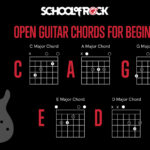The F#7 guitar chord, also known as the F sharp dominant 7th, is a versatile and essential chord for guitarists across various genres. Whether you’re delving into blues, jazz, rock, or pop, understanding and mastering the F#7 will significantly expand your musical vocabulary. This guide provides a comprehensive look at the F#7 chord, exploring different voicings, finger positions, and techniques to help you play it with confidence and musicality.
Understanding the F#7 Chord
Before diving into different ways to play the F#7, it’s helpful to understand what makes up this chord. The F#7 is a four-note chord built on the root note F#. It’s a dominant 7th chord, meaning it includes a major triad (F#, A#, C#) and a minor seventh interval (E). The notes in an F#7 chord are:
- Root (1): F#
- Major Third (3): A#
- Perfect Fifth (5): C#
- Minor Seventh (♭7): E
This combination of notes creates a rich, slightly dissonant sound that is often used to create tension and resolution in chord progressions. Dominant 7th chords like F#7 are crucial in creating harmonic movement and adding color to your playing.
Exploring F#7 Chord Voicings in Standard Tuning
One of the best ways to become comfortable with the F#7 chord is to learn different voicings. Each voicing offers a unique sonic flavor and may be more suitable in different musical contexts or positions on the guitar neck. Here are several common and useful voicings for the F#7 chord in standard tuning:
The F#7 Barre Chord
This is perhaps the most common and powerful voicing for the F#7 chord. It’s a barre chord that provides a full, resonant sound.
This diagram represents the F#7 barre chord. The barre is across all six strings at the 2nd fret. This voicing is movable, meaning you can play other dominant 7th chords by simply shifting this shape up and down the neck.
F#7 Chord Based on the A7 Shape (9th Fret)
Another effective way to play F#7 is by using a chord shape derived from the open A7 chord, but played higher up the neck.
This F#7 voicing is played on the 9th fret and utilizes the shape of an A7 chord. It’s a higher-register voicing, which can be useful for creating different textures and melodic lines.
F#7 Chord Using a C7 Shape (7th Fret)
This voicing borrows the visual shape of an open C7 chord and adapts it to create an F#7. It’s a versatile voicing that sits comfortably in the middle register of the guitar.
This F#7 voicing, reminiscent of a C7 shape, is played at the 7th fret (although the diagram shows 5th fret, a common variation exists at 7th fret as well). It provides a different sonic color compared to the barre chord and A7-shape voicing.
Jazz Voicing for F#7
For a more sophisticated and jazzy sound, this voicing is often employed. It’s a compact voicing that emphasizes the essential tones of the F#7 chord.
This F#7 jazz voicing is a four-note chord that is commonly used in jazz and more complex musical styles. It’s a rootless voicing, meaning it doesn’t include the root note (F#) in this particular fingering, but it functions perfectly as an F#7 chord in context.
F#7 Chord with Thumb Over Technique
For guitarists comfortable with using their thumb to fret the low E string, this voicing provides a different feel and access to the bass note.
This F#7 voicing utilizes the thumb to fret the bass note on the 2nd fret of the low E string. This technique can be useful for creating smooth bass lines and chord changes.
Tips for Playing the F#7 Chord
- Clean Barre Chords: For barre chord voicings, ensure your barre finger is pressing down all strings evenly to avoid buzzing or muted notes.
- Finger Placement: Pay attention to finger placement in each voicing. Position your fingers just behind the frets for clearer sound and less effort.
- Smooth Transitions: Practice transitioning to and from the F#7 chord from other common chords. Smooth chord changes are crucial for fluid playing.
- Context is Key: Experiment with using different F#7 voicings in various musical styles to understand how each voicing contributes to the overall sound.
- Listen Carefully: Listen to recordings of songs that use F#7 chords to hear how they are applied in real musical situations.
Conclusion
Mastering the F#7 guitar chord is a valuable step in your guitar journey. By learning these different voicings and practicing regularly, you’ll not only expand your chord vocabulary but also deepen your understanding of harmony and chord construction on the guitar. Experiment with these voicings, find your favorites, and start incorporating the F#7 chord into your playing to add richness and depth to your music.


